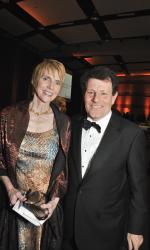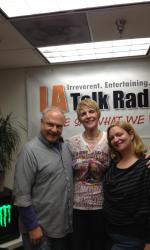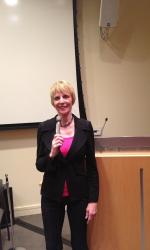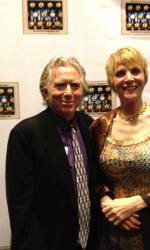 Marti is honored to have met and spoken with Nicholas Kristof at the IFCA Gala. Mr. Kristof co-authored “Half the Sky: Turning Oppression into Opportunity for Women Worldwide,” with his wife, Sheryl WuDunn. He has championed the cause of combatting human trafficking. As a survivor of human trafficking who speaks to raise awareness about this issue, Marti MacGibbon thanked Mr. Kristof for his work. Kristof replied, “Thank you for telling your story.”
Marti is honored to have met and spoken with Nicholas Kristof at the IFCA Gala. Mr. Kristof co-authored “Half the Sky: Turning Oppression into Opportunity for Women Worldwide,” with his wife, Sheryl WuDunn. He has championed the cause of combatting human trafficking. As a survivor of human trafficking who speaks to raise awareness about this issue, Marti MacGibbon thanked Mr. Kristof for his work. Kristof replied, “Thank you for telling your story.”
28, Mar, 2013
Marti MacGibbon meets Nicholas Kristof, International Freedom Conductor Award recipient and Pulitzer Prize winner.
20, Feb, 2013
Marti MacGibbon returns to the Oh, Mary! Show, L.A. Talk Radio in Los Angeles
 Hip and Funny Radio Hosts Mary Kennedy and Paul Jacek welcomed Marti MacGibbon to their uber cool show on L.A. Talk Radio. The Oh, Mary! Show has over 170,000 listeners worldwide. Mary and Paul discussed Marti’s bestselling drug/recovery memoir, Never Give in to Fear: Laughing All the Way Up from Rock Bottom. Both Paul and Mary praised the book, the quality of the writing, and the power of the comeback story. Marti discussed her motivation for writing the book, the power of recovery, and the fact that you can come back from anything, no matter how far down you have gone, with positive thinking, daily renewal, and some effort applied with a sense of humor.
Hip and Funny Radio Hosts Mary Kennedy and Paul Jacek welcomed Marti MacGibbon to their uber cool show on L.A. Talk Radio. The Oh, Mary! Show has over 170,000 listeners worldwide. Mary and Paul discussed Marti’s bestselling drug/recovery memoir, Never Give in to Fear: Laughing All the Way Up from Rock Bottom. Both Paul and Mary praised the book, the quality of the writing, and the power of the comeback story. Marti discussed her motivation for writing the book, the power of recovery, and the fact that you can come back from anything, no matter how far down you have gone, with positive thinking, daily renewal, and some effort applied with a sense of humor.
Marti MacGibbon has been doing a lot of radio interviews to promote Never Give in to Fear. The book is a darkly funny, cautionary tale, and an inspiring comeback story. As San Francisco Book Review said, “Never Give in to Fear is a book everyone needs to read. This is not only a story about the danger of drugs, but about the power of the human spirit.”
18, Feb, 2013
Museum of Tolerance, Los Angeles features Marti MacGibbon, Human Trafficking Survivor Turned Activist, as Guest Speaker
 Marti MacGibbon’s powerful comeback story inspired and moved listeners at The Museum of Tolerance in Los Angeles yesterday. Event organizer Elana Samuels praised Marti for her courage and vulnerability in presenting this difficult topic to a full auditorium. Audience members included a class of high school students, and a diverse demographic. MacGibbon, a veteran standup comic and professional inspiration speaker, shared how she found her courage while imprisoned, threatened with death, raped, abused and isolated by Japanese organized crime figures. The audience was riveted by by the details of her escape and journey through trauma to healing, and the touching story of how she met her true love while homeless and suffering from PTSD elicited an applause break. Marti uplifted audience members with appropriate humor, and offered tips on overcoming adversity and becoming acquainted with their own deep and powerful inner strength. This is Marti’s second appearance at the MOT, and staff has expressed the desire for her to return again and again. Not many people come back from experiences as harrowing as Marti’s, and regain the strength and courage to share their story with others. Marti’s honesty and openness are disarming, and listeners gain insight into how difficult it is for victims of human trafficking to recover after rescue. This terrible global crime must be extinguished. All human beings deserve the right to freedom, autonomy, and dignity.
Marti MacGibbon’s powerful comeback story inspired and moved listeners at The Museum of Tolerance in Los Angeles yesterday. Event organizer Elana Samuels praised Marti for her courage and vulnerability in presenting this difficult topic to a full auditorium. Audience members included a class of high school students, and a diverse demographic. MacGibbon, a veteran standup comic and professional inspiration speaker, shared how she found her courage while imprisoned, threatened with death, raped, abused and isolated by Japanese organized crime figures. The audience was riveted by by the details of her escape and journey through trauma to healing, and the touching story of how she met her true love while homeless and suffering from PTSD elicited an applause break. Marti uplifted audience members with appropriate humor, and offered tips on overcoming adversity and becoming acquainted with their own deep and powerful inner strength. This is Marti’s second appearance at the MOT, and staff has expressed the desire for her to return again and again. Not many people come back from experiences as harrowing as Marti’s, and regain the strength and courage to share their story with others. Marti’s honesty and openness are disarming, and listeners gain insight into how difficult it is for victims of human trafficking to recover after rescue. This terrible global crime must be extinguished. All human beings deserve the right to freedom, autonomy, and dignity.
16, Feb, 2013
Marti MacGibbon distributes copies of her bestselling addiction memoir, “Never Give in to Fear” at the Experience, Strength and Hope Awards in Los Angeles
 Past recipients include Louis Gossett Jr., Ed Begley, and Buzz Aldrin. This year’s recipient was John Taylor, of the rock band, Duran Duran. Robert Downey Jr. presented the award, and Bobcat Gouldthwait knocked it out of the park with a blisteringly funny standup performance. Leonard Buschel, founder and creator of Reel Recovery Film Festival, Writers in Treatment, and the Experience, Strength and Hope Awards, graciously gave Marti permission to hand out complimentary signed copies of Never Give in to Fear to selected attendees who expressed interest in reading it. Marti’s purpose in writing her bestselling memoir is to encourage, inspire, and entertain readers while vivdly describing the consequences of addiction and the very real possibility of recovery, even for the seemingly hopeless cases (and Marti was one). With 17 years of continuous recovery, coupled with education and training in addiction treatment, Marti MacGibbon is a powerful and effective speaker on alcohol and drug awareness, and her presentations are humorous as well as informative and content-rich. To book her for a presentation or book signing at your facility, sober living, or group, contact Marti through this website, martimacgibbon.com, or call 310 210 4674.
Past recipients include Louis Gossett Jr., Ed Begley, and Buzz Aldrin. This year’s recipient was John Taylor, of the rock band, Duran Duran. Robert Downey Jr. presented the award, and Bobcat Gouldthwait knocked it out of the park with a blisteringly funny standup performance. Leonard Buschel, founder and creator of Reel Recovery Film Festival, Writers in Treatment, and the Experience, Strength and Hope Awards, graciously gave Marti permission to hand out complimentary signed copies of Never Give in to Fear to selected attendees who expressed interest in reading it. Marti’s purpose in writing her bestselling memoir is to encourage, inspire, and entertain readers while vivdly describing the consequences of addiction and the very real possibility of recovery, even for the seemingly hopeless cases (and Marti was one). With 17 years of continuous recovery, coupled with education and training in addiction treatment, Marti MacGibbon is a powerful and effective speaker on alcohol and drug awareness, and her presentations are humorous as well as informative and content-rich. To book her for a presentation or book signing at your facility, sober living, or group, contact Marti through this website, martimacgibbon.com, or call 310 210 4674.
20, Jan, 2013
Sure-fire Strategies for Healing and Coming Back from Adversity

 Adversity, personal injury, grief and loss can make you feel as though you have lost touch with yourself, but the truth is that adversity introduces us to our real selves. When you survive something awful, you have the opportunity to increase your personal power, strength of character, and ability to contribute to the greater good based on how you react to and rebound from the adversity.
Adversity, personal injury, grief and loss can make you feel as though you have lost touch with yourself, but the truth is that adversity introduces us to our real selves. When you survive something awful, you have the opportunity to increase your personal power, strength of character, and ability to contribute to the greater good based on how you react to and rebound from the adversity.
I’m a survivor of global human trafficking, domestic violence, hard-core drug addiction and homelessness. For years, I allowed adversity to change the way I thought about myself, other people and the world, and to hold me back from recovery. But then I discovered the power of the present moment. I realized that I held the key to my destiny and my own happiness. I began to take steps to change my thinking, and I turned my life around. I quit drugs, recovered, and began to discover my true purpose in life. And it didn’t really take very long to see amazing results.
Today, I’m a professional inspirational speaker, standup comic, certified addiction treatment professional and author of, “Never Give in to Fear: Laughing All the Way Up from Rock Bottom,” an Amazon #1 bestselling memoir. I’m a member of the National Speakers Association and articles I wrote have appeared in over 100 magazines and trade publications. Investors Business Daily and Entrepreneur have interviewed me. I speak as a survivor to raise awareness about human trafficking, and I’ve spoken at the Freedom Center in Cincinnati, the Museum of Tolerance in Los Angeles, and even from the center of an MMA octagon. I’m a resilience expert who speaks on overcoming adversity, Kickass Personal Transformation and alcohol and drug awareness.
Here are some of the steps I took and strategies I used to turn my life around:
Get Connected and Stay Connected. Don’t try to recover from adversity or tragedy on your own. You don’t have to suffer in isolation or try to suppress your feelings of hurt, anger, grief or fear. Seek expert help from a licensed competent therapist, doctor, clergy, or counselor. Cognitive Behavioral Therapy (CBT) will empower you. Find a support group and a mentor and start building a network of people who understand what you’ve been through. You can tell your story to empathic individuals, listen to others’ accounts of their experiences and how they came back from them. And when you’re ready, get started helping others and complete the healing cycle!
Review All Your Experiences, Take Courage, and Ask Yourself, “What’s Next?” Allow yourself to review past events and reinterpret them, drawing strength from all your experiences. As you look back at your life, step back and look at yourself objectively, as if you’re watching a movie. Give yourself credit for strength, grace, and other admirable qualities, and refrain from judging yourself or others. Find courage where you can, humor where you can. Find your life story, or you may want to think of it as a “life movie” where you are the director. Cast yourself as the hero in an Oscar-winning comeback story, and write a powerful third act with a triumphant ending.
 Having a Bad Experience Does Not Make You a Bad Person. If something bad has happened to you, it’s easy to want to blame yourself, or to revisit the memory and try beat yourself up with thoughts such as, “If I only hadn’t…” or, “It happened because I…” or “This is all my fault.” Of course, its healthy to take responsibility for bad judgment that brings you into harm’s way, or to look at your part in situations, but don’t blame yourself. Sometimes bad things happen for no reason at all, and many things in life are beyond our control. The one thing you definitely have control over is your attitude, and how you think about yourself, other people, and life in general. Keep a positive outlook, and be your own best friend.
Having a Bad Experience Does Not Make You a Bad Person. If something bad has happened to you, it’s easy to want to blame yourself, or to revisit the memory and try beat yourself up with thoughts such as, “If I only hadn’t…” or, “It happened because I…” or “This is all my fault.” Of course, its healthy to take responsibility for bad judgment that brings you into harm’s way, or to look at your part in situations, but don’t blame yourself. Sometimes bad things happen for no reason at all, and many things in life are beyond our control. The one thing you definitely have control over is your attitude, and how you think about yourself, other people, and life in general. Keep a positive outlook, and be your own best friend.
Focus on the Present Moment, Refuse to Live in the Past. You can’t change the past, and the only way you can affect the future is in this moment, right now. Focus on the present moment, knowing that you have the power, in the now, to create positive thoughts and feelings about yourself. The key to your destiny and your own happiness can be found in the present moment. Make a conscious decision to access the power of the present moment to feel good about yourself, your life, and your future. Practice respecting, loving and appreciating yourself.
Make an Action Plan for the Present and Future. Resilience involves taking positive action. Action is empowering and motivating. People who are resilient are flexible, optimistic and hold a clear vision of where they want to go and what they want to accomplish. Set measurable, do-able goals, and when you accomplish those goals, celebrate them. It’s okay to move ahead with baby steps, as long as you recognize the importance and value of each small step forward. Be optimistic and keep hope alive.
Use Mantras, Positive Affirmations and Visualization to Build Your Self-Image and Recognize Possibilities. These are tools you can employ to increase the levels of “feel good” neurotransmitters in your brain. A mantra is a short, sometimes alliterative phrase that you use to focus on the positive and keep yourself balanced. I used, “I’m healing,” “It’s temporary,” and when I first quit drugs, my favorite mantra was, “There’s hope after dope.” Affirmations are self-enhancing statements, written in present tense, that you read aloud to yourself right before you go to sleep at night. Visualization is the conscious act of “seeing” the things you want to have happen in your life, and feeling a strong positive emotion while you’re visualizing. Also, when you visualize, “see” it as though you already have it and feel how good that feels.
Always Use Positive Self-Talk. Become conscious of the words you speak, and of the dialogue within your mind. Keep up a constant inner pep talk. Tell yourself you’re strong and getting stronger, happy and becoming happier. Constantly tell yourself good stories. We often create our inner lives with our own words.
Practice Mindfulness Meditation to Improve Your Consciousness in the Present Moment. As you begin to appreciate the power of the present moment, concentrate on developing your “now awareness.” Mindfulness meditation is a powerful tool that can help you reduce and manage stress, elevate your mood, relieve anxiety, and increase your confidence and self-esteem. Mindfulness meditation can be practiced in a number of ways and need not be complicated.
One way to do it is to sit in a comfortable chair with both feet planted firmly on the floor. Relax, breathe slowly, and simply observe your body, the level of tension or relaxation in different muscle groups, for instance. Observe thoughts as they pass through, like clouds across the sky. Observe any emotions that may be present, either in response to a thought or for no apparent reason at all. The purpose is to simply observe without judging or reacting, in the moment.
Another way to practice mindfulness is to take a walk outside in nature, consciously experiencing the world through all the senses. Or watch a sunset or sunrise and focus all your consciousness in the present moment as the sun sinks or climbs over the horizon and the landscape is illuminated or drenched in shadow. As long as you fully inhabit the “now.” At first you may only do a minute at a time, but the idea is to increase the duration each day till you have a block of time, say 20 minutes, devoted to mindfulness.
16, Jan, 2013
Human Trafficking: I Survived, Healed and Now Help Others

 My name is Marti MacGibbon, and I’m a human trafficking survivor. In 1985, I was a standup comic with a scheduled appearance on The Tonight Show with Johnny Carson. Despite my success, my recreational drug use spiraled into addiction, and I became entangled in the San Francisco drug scene. This fact, and an abusive relationship I was desperate to escape from⎯made me vulnerable to traffickers. I was trafficked from San Francisco to Tokyo and found myself completely under the control of Japanese organized crime figures⎯threatened, brutalized, isolated, and absolutely terrified. I feared I would not survive the experience, but I am one of the lucky ones. After less than two months, a “customer” helped me to escape⎯I am convinced that he purchased my freedom, as he was a smuggler with contacts in the nether world of drugs and other contraband, capable of accomplishing this feat.
My name is Marti MacGibbon, and I’m a human trafficking survivor. In 1985, I was a standup comic with a scheduled appearance on The Tonight Show with Johnny Carson. Despite my success, my recreational drug use spiraled into addiction, and I became entangled in the San Francisco drug scene. This fact, and an abusive relationship I was desperate to escape from⎯made me vulnerable to traffickers. I was trafficked from San Francisco to Tokyo and found myself completely under the control of Japanese organized crime figures⎯threatened, brutalized, isolated, and absolutely terrified. I feared I would not survive the experience, but I am one of the lucky ones. After less than two months, a “customer” helped me to escape⎯I am convinced that he purchased my freedom, as he was a smuggler with contacts in the nether world of drugs and other contraband, capable of accomplishing this feat.
When I returned to San Francisco, petrified of reprisals by the traffickers, I fled the city and sought refuge in the redwood country north of San Francisco. But I could not find a safe place within my own mind after the things I experienced in Tokyo. Night terrors plagued my sleep, and I doubted my own sanity and self-worth. In those days, few resources were readily available. The term, “human trafficking,” was not yet a part of the popular lexicon, and the legislative advances of ensuing decades had not yet occurred.
Suffering from post traumatic stress, I wandered homeless for over a year, sleeping in abandoned houses and under bridges, ashamed to call my family or friends for help. Of course I couldn’t even consider going to the authorities. I was certain they would lack compassion, and might even arrest me for being under the influence of the drugs I used in an attempt to cope with my fear, shame and trauma. I suffered in silence, and my addiction nearly consumed me. For ten long years, I could not find a safe place within my own mind.
Eventually, I recovered from addiction and began the long process of healing and rebuilding my life. The first step in recovery from trauma is to find a safe place within. I learned to trust, and to forgive, and to believe in my own self-worth. I became aware of the power of love and gratitude and the trust that holds the universe together. I returned to standup comedy and enjoyed some success. But it wasn’t until 2005 that I told anyone about what had happened to me in Japan. For twenty years, I still suffered from nightmares, every night, until I found help through a skilled therapist and licensed clinical social worker who helped me find treatment for PTSD.
I am grateful that I survived, and grateful for the opportunity to banish the fear and shame that held me in thrall for so many years. Fear and shame are the traffickers’ weapons. They count on, even bank on the silence of victims and witnesses. I will not be silenced. The things that I endured in Japan have changed me forever, but they do not define me. I carry the realization that the happiness I experience today is not in spite of, but because of, the things I have overcome.
Today, I hold four certifications in addiction treatment, and I am dedicated to helping others who suffer from the disease that nearly killed me. I am a member of the National Speakers Association, and author of, Never Give in to Fear: Laughing All the Way Up from Rock Bottom, a memoir that tells my personal story. And I speak to raise awareness about human trafficking, in hopes that I can make some contribution to the modern day abolitionist movement.
Human trafficking, in all its manifestations, can seem overwhelmingly difficult to combat. But I know there is reason for hope. President Obama has proclaimed January as National Slavery and Human Trafficking Prevention Month, and I applaud all the progress that’s been made to raise awareness about this issue. Grassroots organizations such as Free the Slaves, Polaris Project, and Not for Sale work to provide a safe place for victims of human trafficking to begin the healing journey, and I stand in awe of such efforts. May all those who stand against exploitation triumph in the struggle to abolish this terrible global crime.
7, Jan, 2013
See it, Believe it, and Achieve it
 One of the best ways to deal with a post-holiday slump — or mid-winter blues — is to engage in a daily practice of positive visualization. Visualization is a powerful force, and whether we are aware of it or not, the unconscious mind constantly sends and receives visual messages, images of things we want, or don’t want, in our lives. If you allow negative, default visualization to run through your mind all day, you may notice the negative emotions resulting from the negative images: anxiety, disquiet, frustration, hopelessness, melancholy. On the other hand, when you make positive visualization a regular part of your day, every day, you experience positive emotions like peace, joy and love, and you’ll notice an increase in your creativity, inspiration, and optimism. In short, your attitude will improve. And attitude is everything!
One of the best ways to deal with a post-holiday slump — or mid-winter blues — is to engage in a daily practice of positive visualization. Visualization is a powerful force, and whether we are aware of it or not, the unconscious mind constantly sends and receives visual messages, images of things we want, or don’t want, in our lives. If you allow negative, default visualization to run through your mind all day, you may notice the negative emotions resulting from the negative images: anxiety, disquiet, frustration, hopelessness, melancholy. On the other hand, when you make positive visualization a regular part of your day, every day, you experience positive emotions like peace, joy and love, and you’ll notice an increase in your creativity, inspiration, and optimism. In short, your attitude will improve. And attitude is everything!
Visualization sessions don’t need to be long. I’ve found that about fifteen or twenty minutes a day is beneficial, and it doesn’t take a lot of planning to set aside that much time. The first step in visualization is to relax. Breathe slowly and deeply, and find a comfortable place to sit or lie down. Close your eyes and let your mind and your muscles unwind. Concentrate on the present moment, and be aware of your body, your senses, and your emotions. Consciously engage in feeling any of the positive, “higher” emotions: love, peace, joy, enthusiasm, gratitude. Then begin to create and to project the positive images in your mind’s eye.
If you’re currently working toward a deadline, you may choose to visualize yourself completing your project early. See yourself finishing up the work, getting excellent results, and celebrating the accomplishment. While you are visualizing, be sure to continue to feel the positive emotions — see yourself accomplishing, and then feel how good it feels to arrive at the deadline early. Strong positive emotion will turbo-charge your visualization, and it also will help your brain to manufacture more of the “feel good” neurotransmitters such as dopamine and serotonin.
Positive visualization, when channeled consciously, will propel you forward toward your goals and dreams. Athletes visualize each and every movement in an upcoming race or game, and visualize winning. Performers visualize themselves onstage, getting a standing ovation, etc. If you can see it, you can believe it, and if you can believe it, you can achieve it. As you’re envisioning all of this, and experiencing the strong positive emotion, exercise your faith, that is, a feeling of confidence and certainty that this is possible.
It’s okay to start small and work your way up. Begin with a a minute or two of visualization each day. Allow yourself to experiment: set a short term, easy-to-reach, but measurable goal, and visualize your way to it. If you try this, without judging, and with an open mind, you will be surprised how quickly you’ll see results. The simple act of relaxing and visualizing a peaceful scene can reduce stress, increase energy and elevate mood.
If you’re reading this, and you’re already proficient in the art of visualization, please comment and share some of your favorite techniques for relaxing, or ways that you have used visualization to your benefit. Or maybe you’d like to share some of the things you’ve achieved with the help of visualization. I look forward to hearing from you.
26, Dec, 2012
Overcoming Public Speaking Fear: Surefire Techniques
 I love speaking and doing standup. I’ve performed in front of audiences of thousands and wowed them, and groups of less than a dozen people, and done just as well. But I didn’t start out that way. I learned by trial and error. And I learned some valuable techniques that I now use in any and every public speaking situation. You can use these tips and probably save yourself some of the growing pains I experienced.
I love speaking and doing standup. I’ve performed in front of audiences of thousands and wowed them, and groups of less than a dozen people, and done just as well. But I didn’t start out that way. I learned by trial and error. And I learned some valuable techniques that I now use in any and every public speaking situation. You can use these tips and probably save yourself some of the growing pains I experienced.
When I started doing standup, I sought the advice of comics I admired. I asked them how to be a better performer. Most comics told me to simply keep getting up on stage. And they were right – there’s no teacher like stage time. But I needed more. I needed to learn how to achieve consistency. At that point in my progress, it was always a roll of the dice: some nights my set would kill, other nights I’d bomb. I longed to find out what magical ingredient would carry the day.
Some comics threw out buzz phrases I’ve seen in books about public speaking, specifically, “Be confident,” and “Present yourself without fear.” I would accept their sage advice with a dutiful nod, and scuttle off to a corner to stifle the frustration I felt over how to actually arrive at a state of confidence or fearlessness in front of an audience.
After years of doing standup every night, I learned some solid, evidenced-based methods that work for me and will work for anyone if put into practice consistently. I divide these tips into two categories: Internal and External. I’m going to cover some the External, or mechanical ones here.
There are a number of ways to arrive at confidence externally, that is, to use your physical aspect to arrive at a psychological steadiness; a feeling of ease and competence while speaking in front of an audience. At the very least, these tips will help you create the illusion of confidence till the real thing arrives. Here are a few examples:
Smile. When you’re rehearsing, each time you anticipate the upcoming presentation, and on stage. A recent study found that the smiling – simply using the muscles involved – sends a message to the brain that improves mood. In other words, look happy and you’ll be happier. So slap that smile on your face and “act as if.” You’ll get there. And your audience will automatically find it easier to like you. That’s half the battle!
Assume a confident stance. Stand up straight, throw your shoulders back, never, ever look down at the floor. Confident posture projects confidence to your audience and to yourself as you begin speaking. Soon you “grow into it,” as the audience responds to your projection, you realize you actually feel confident. If you want to triumph, assume a warrior’s stance – with your weight evenly distributed and both feet planted. Never shift your weight to one foot or the other.
Make eye contact. Or at least create the illusion that you are making eye contact. Don’t look out in the distance and zone out. Make friends with the audience, or even with one member.
Always move toward the audience, never allow yourself to back away. That sends a signal of retreat. Always advance.
Use your body on stage to express your enthusiasm and energy. If you can find a place to do this without looking nuts, then before you go on stage, run in place or stretch. This can help you to loosen up your muscles so you appear more relaxed. It can also establish a flow of energy to channel nervousness. Use strong gestures. Never clasp or wring your hands, better to talk with them. Let your hands get into the act. Avoid nervous pacing.
Pause before you begin to speak, and to emphasize points. It makes you look like you’ve got it together and have no doubt that things will go well. Good standup comics know to wait after a punchline till all the laughs die down, so you positively ooze confidence. So pause, breathe, and move on to the next point.
Practice any or all of these methods and I think you’ll notice a difference. Keep on practicing them and you’ll not only excel, but you will pick up additional techniques and strategies of your own. Lead with the body and the mind will follow. Fake it till you make it.
Overcoming Fear of Public Speaking: Prepare Your Mind and Find Your Motivation
 Experts agree that fear of public speaking is one of the most common, if not the most common, phobias in modern society. This doesn’t surprise me. What does in fact, amaze me, is that millions of people who fear public speaking are required to do it on a regular basis – at work, doing presentations and reports, for example – and they suffer miserably as a result. They endure silently in order to keep their career positions. Many resort to powerpoint, so they can hover in darkness and simply read from the screen, rather than interact with their audience.
Experts agree that fear of public speaking is one of the most common, if not the most common, phobias in modern society. This doesn’t surprise me. What does in fact, amaze me, is that millions of people who fear public speaking are required to do it on a regular basis – at work, doing presentations and reports, for example – and they suffer miserably as a result. They endure silently in order to keep their career positions. Many resort to powerpoint, so they can hover in darkness and simply read from the screen, rather than interact with their audience.
But it’s the interaction with the audience that brings the fun, the funny, the thrills, and all the other benefits of public speaking. In addressing a group of our fellow human beings, we have the opportunity to “plug in” to the mainframe of the human experience. It’s a relationship. We’re making friends with our audience. When our audience accepts us, our ideas, we experience the sense of being a part of something greater than ourselves.
Preparedness is essential in public speaking. Of course, we prepare our material, what we’re going to say. But often as speakers we get so wrapped up in the words we plan to say that we forget the spirit, the energy, the passion of our message. I always ask myself, What am I bringing to the relationship? Am I approaching my audience with respect – do I want them to benefit from this – or am I only worried about my ego? Am I speaking from the heart? What do I love about my message? About this speaking opportunity? About this audience?
If I fill myself with love and good feelings, there’s no room for fear. We can only truly experience one emotion at a time. I learned early in standup that it’s how you feel when you’re up there that powers the whole show. Enthusiasm, passion, fun — these are infectious and they attract a like response from the audience. It’s exactly the same in a one to one relationship, isn’t it? Anyone who’s been on a date or experienced a friendship knows it’s true.
As in relationships, mutual respect is a very important ingredient in successful public speaking. If I prepare myself by thinking about all the things I respect about my audience, and I carry that respect onto the stage, I will likely receive respect in return.
I disagree with many of the “tips” that are offered to people as solutions to fear of public speaking. I’ve heard it said that a speaker or performer should regard the audience as of no consequence, or imagine the audience in diapers, or naked, or in their underwear. I disagree. Why should my having confidence require me to think of my audience as negated, humiliated or compromised?
An angry young standup comic once told me, “ Before every show, I prepare myself — I think of the audience as one person – one person I have to fight – and the fight is to the death!! I visualize myself jumping onto the stage and ripping their (the audience’s) face off!” This guy frequently got laughs for a minute or two, but invariably the audience turned on him. His energy was a downer. He made them feel uncomfortable and they couldn’t like him. How could they like a guy who visualizes an adversarial exchange? (Eventually, he changed his attitude and audiences came along with him. He became a successful comic.)
We want to speak it the way we live it – with optimism, passion, gratitude, and the ability to refrain from taking ourselves too seriously. When our eyes are open to possibilities, we can always find a way to bring these things onto the stage and to muster enthusiasm. Make a list of the things you love. Start each entry with, “I love it when…” or, “I love…” Then, before stepping up to the microphone or the podium, take time to read the list to yourself. Or memorize part of it and run it back and forth in your head before you step up to speak. Fill yourself with love and the fear will roll over and shove off!
4, Dec, 2012
Enter the Kickass Creative Zone
 In your thinking, what kind of Kickass Moves do you have? Are you flexible enough? Or are you too rigid? Flexibility is a quality worth developing, maintaining and exploring. People who cultivate a flexible way of looking at themselves and at challenging situations, generally find solutions to problems and satisfaction — or even happiness — in life. An adaptable way of thinking helps us to address problems from many different angles, while a more rigid “set in your ways” type of thinking will hem you in, tap your creativity and limit your options. A supple mind is an open mind, able to embrace new and exciting experiences, generate creative concepts, adapt to change, and triumph over adversity. Here are three Kickass Ways to rattle your thought-cage and cut you loose to enter your Kickass Creative Zone:
In your thinking, what kind of Kickass Moves do you have? Are you flexible enough? Or are you too rigid? Flexibility is a quality worth developing, maintaining and exploring. People who cultivate a flexible way of looking at themselves and at challenging situations, generally find solutions to problems and satisfaction — or even happiness — in life. An adaptable way of thinking helps us to address problems from many different angles, while a more rigid “set in your ways” type of thinking will hem you in, tap your creativity and limit your options. A supple mind is an open mind, able to embrace new and exciting experiences, generate creative concepts, adapt to change, and triumph over adversity. Here are three Kickass Ways to rattle your thought-cage and cut you loose to enter your Kickass Creative Zone:
Introduce Change into Daily Routine. This is basic and rudimentary, but it does get results. When you break up the habitual order of everyday, mundane tasks, you kick-
start your brain into a “growth pattern,” stimulating the development of new synaptical connections. Here are a couple of examples…Just for fun, I sometimes hold my toothbrush with my left hand, instead of my right. Now and then, my husband changes the way he shaves in the morning — starting at his right ear instead of his left, and shaving the area around his chin first instead of shaving above his upper lip region. Both of these variations from habit require mindful attention to the task and make the brain sharper and more adaptable.
Explore New Activities and Meet New People. This expands your horizons and increases self-confidence. You’ll also expand your network and learn valuable new things. You don’t have to skydive or climb Mt. Everest to be adventurous. Never limit yourself with rigid thoughts such as, “These aren’t my kind of people;” “I’d never fit in;” “What would people think?” Reject all of the old, stodgy excuses — too young, old, broke, smart, stupid, cool, scared, etc. Open your mind to unlimited possibilities and refuse to take yourself too seriously. Focus on the fun, forget the fear and see how rich your experience will be.
Practice Mindfulness. Just take some time to pay attention and be consciously aware of what you are doing, instead of automatically and thoughtlessly executing tasks. One easy (and calming) exercise to try is to pay attention to your breathing. Notice how your lungs expand and contract. Then hold your breath for a second when your lungs are full, and wait a second before inhaling when your lungs are empty. Another area in which to pay attention is eating. Chew and savor each bite of food — contemplating its flavor, texture, mouthfeel, source and nutritional value — instead of chomping and gobbling it down just to get to the next piece. You can also practice mindfulness watching a sunset, taking a walk, or sipping a cup tea.
The quickest way to change your thinking and your attitude is to take action. So why wait? Bust a Kickass Move.
